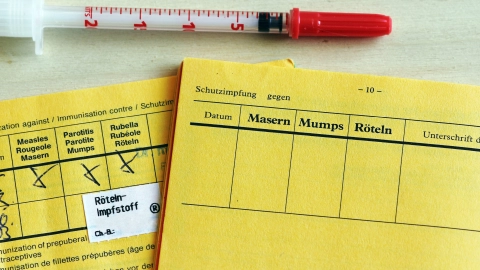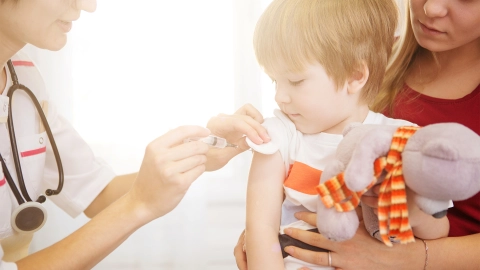Conditions Roseola
ICD codes: B08.2 What are ICD codes?
Roseola is a common viral infection that affects infants and small children. A high temperature is usually followed by a pinkish rash, especially on the torso and neck. The infection is usually harmless and measures are only needed to relieve the symptoms.
At a glance
- Roseola is a highly contagious, usually harmless viral infection that affects infants and small children.
- Typical symptoms include a high temperature that lasts for several days followed by a rash.
- Other flu-like symptoms can also occur, and occasionally even febrile seizures. In most cases, febrile seizures are not harmful and don’t last long.
- It is important for children with the condition to drink lots of fluids.
- Measures to lower their temperature may also be beneficial.
Note: The information in this article cannot and should not replace a medical consultation and must not be used for self-diagnosis or treatment.

What is roseola?
Roseola, often also called sixth disease or three-day fever, is a common, usually harmless viral condition that affects infants and small children. Typical symptoms include a high temperature that lasts for 3 to 5 days followed by a patchy, pale red rash. Doctors also refer to roseola as roseola infantum or exanthema subitum.
As the body may lose a lot of fluid due to the high temperature, it is important for sick children to have plenty to drink. Antipyretic (fever-reducing) suppositories and lukewarm compresses can also be helpful in reducing temperature.
Roseola is triggered by certain herpes viruses. However, these should not be confused with the pathogens of oral herpes or genital herpes, which also belong to the herpes family of viruses.
What are the symptoms of roseola?
Roseola typically progresses in two phases: a high temperature phase and a subsequent rash. There are also forms with very mild symptoms. In some cases, the condition is barely perceptible.
High temperature phase
About 1 to 2 weeks after infection, a high temperature develops, often rising to over 39.5 degrees and generally lasting 3 to 5 days. Children may be very weak or irritable while their temperature is elevated. However, some children are only affected very slightly by their high temperature.
In addition to the high temperature, other symptoms are also possible, such as:
- diarrhea and vomiting
- a cough and a runny nose
- an inflamed throat with red spots on the roof of the mouth and uvula (the small piece of soft tissue that hangs down from the back of the mouth)
- swollen lymph nodes in the throat
- swollen eyelids
- in infants, a taut and bulging fontanelle – the soft part of the skull where bone formation is not yet complete
Rash phase
At the end of the high temperature phase, the body temperature usually returns to normal very quickly. At the same time, a rash with small pink spots or slight nodules that are not usually itchy forms within hours.
The rash primarily appears on the torso and neck but can also spread to the arms, legs and face. It disappears again after a few days – or in some cases after just a few hours. Once the rash appears and the fever has subsided, children are usually no longer infectious.
Video Are childhood diseases dangerous?
The video below outlines the most common childhood diseases and the symptoms they present.
This and other videos can also be found on YouTube
Watch nowThe privacy policy indicated there applies.
What causes roseola?
Roseola is triggered by certain herpes viruses, usually human herpesvirus 6 and, in rarer cases, human herpesvirus 7. The pathogens are also found in healthy people, such as the older siblings or parents of the sick child. The viruses are very contagious and are likely to be transmitted by saliva droplets, for example when coughing and sneezing or during close physical contact. There is no vaccination.
By the age of 3, almost all children come into contact with the pathogens that cause roseola at some point. Only a certain number of infants and small children develop symptoms. Often, infection has no effect and does not cause any symptoms. Following an infection, part of the virus remains in the body for life.
If the immune system becomes very weak, for example, due to cancer, the herpes viruses can become active again. In people with an immune deficiency, complications such as inflammation of the brain (encephalitis) can occur.
How is roseola diagnosed?
Pediatricians diagnose roseola on the basis of the typical symptoms: a high temperature that lasts for several days then rapidly disappears followed by a rash.
If no rash has yet developed, roseola is hard to distinguish from other conditions that cause a high temperature. In such cases, doctors may wish to rule out other causes for the fever. For example, a urine test can rule out any inflammation of the bladder or kidneys that requires treatment.
How is roseola treated?
With roseola, it generally suffices to treat the symptoms. Antipyretic suppositories and lukewarm compresses can help to reduce the high temperature.
It is important for sick children to drink plenty as infants and small children in particular lose a lot of fluid when they have a high temperature. Water, diluted juice or tea are suitable choices. If the child refuses to drink, the parents should contact a doctor immediately.
If the child experiences a febrile seizure during the high temperature phase, he/she should not be held too tightly and should be protected against injury. In particular, if a child is having a febrile seizure for the first time or the seizure lasts for more than 5 minutes, it is important to call the emergency number 112. An emergency doctor can then monitor the child’s vital bodily functions. If the febrile seizure doesn’t stop on its own, medication can also be administered to break it. Other causes of the seizure must then be ruled out.
It can be frightening to witness a febrile seizure, but they generally do not cause any lasting harm.
The German Society of Pediatrics and Adolescent Medicine (Deutsche Gesellschaft für Kinder- und Jugendmedizin e.V., DGKJ) has compiled extensive information for parents about febrile seizures.
Further information on febrile seizures and how to treat them can be found at gesundheitsinformation.de.
- Berufsverband der Kinder- und Jugendärzte e.V. (BVKJ). Kinder- und Jugendärzte im Netz. Drei-Tage-Fieber. Aufgerufen am 21.03.2025.
- Deximed (Internet). Dreitagefieber, Exanthema subitum. Aufgerufen am 25.03.2025.
- DynaMed (Internet), Ipswich (MA). Roseola Infantum. Aufgerufen am 21.03.2025.
- Mullins TB, Krishnamurthy K. Roseola Infantum. In: StatPearls [Internet]. Aufgerufen am 21.03.2025.
- UpToDate (Internet). Roseola infantum (exanthem subitum). Aufgerufen am 21.03.2025.






